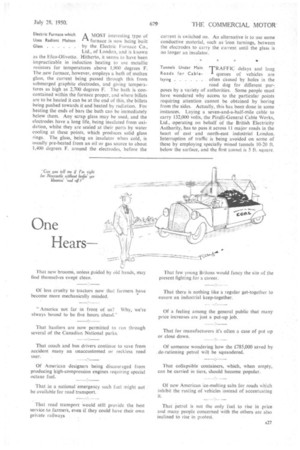Passing Comments
Page 28

Page 29

If you've noticed an error in this article please click here to report it so we can fix it.
Bridge Sights for A R MY training includes a Double-deck .hints on how to judge Bus distances. "If a man standing
. appears to be the same height as the foresight blade of a rifle, he will be so far away; if kneeling, so much nearer. Now there comes a novel extension of the principle. Mr. C. AnsonSmith, B.Sc., headmaster of a Leicester secondary school, is taking some of his boys for a holiday in Spain in a 1934 Leyland Titan, which is 14 ft. 6 ins. high. As a precaution against hitting the arches of bridges, two horizontal lines have been painted on the windscreen, when superimposed on an object 20
yds. ahead, these indicate the height of the bus. If a doubtful bridge he encountered, a halt 20 yds. in front is made with the lower line registering on the foot of the bridge at the crown of the road. It can then be seen where the upper line falls relative to the arch. This idea might well be worth adoption in other vehicles.
A Clearing House MILLIONS of bills for haulfor Bills from "I age are being cleared
Hauliers annually in America under a group system known as Transport Clearings. Each main centre has its own branch, and each haulier member sends his bills to that organization, instead of to his individual customers. T.C. then adds un the bills going to different A26
companies and arranges to obtain the total amounts, the members then being paid accordingly with a reduction of slightly under 1 per cent. for this service on the amount cleared for them. One advantage is that lists of "bad payers" can be supplied to mem-.
bets. A board of governors and the executives necessary are elected annually by the members. Such a scheme might save hauliers in this country a great deal of work and worry.
Presence of Mind
in a Startling BWEEN Los Angeles and 1-'1 San Francisco there is a
fairly steep gradient running
Emergency . . . for five miles. The driver of a tractor-lorry carrying 15 tons of beer was descending this when he saw ahead a lorry and trailer, the brakes of which were smoking thickly, whilst the driver was attempting to slow the vehicle by steering it at an angle into the bank at the side of the road. The combination with its 20-ton load continued to gain speed and might have proved a grave danger to other vehicles climbing the gradient. With commendable pluck and rapidity of decision, the driver Of the beer outfit pursued the runaway and whet he had drawn level shouted "Get behind me." He accelerated until he was a little way in front and then gradually applied his brakes. There was only a slight bump, and the vehicles gradually came to a standstill. Electric Furnace which A MOST interesting type of Uses Radiant Molten 1-1 furnace is now being built Glass by the Electric Furnace Co.,
Ltd., of London, and is known as the Efco-Olivotto. Hitherto, it seems to have been impracticable in induction heating to use metallic resistors for temperatures above 1,900 degrees F. The new furnace, however, employs a bath of molten glass, the current being passed through this from submerged graphite electrodes, and giving temperatures as high as 2,700 degrees F. The bath is concontained within the furnace proper, and where billets are to be heated it can be at the end of this, the billets being pushed towards it and heated by radiation. For heating the ends of bars the bath can be immediately below them. Any scrap glass may be used, and the electrodes have a long life, being insulated from oxidation, whilst they are sealed at their ports by water cooling at these points, which produces solid glass rings. The glass, being an insulator when cold, is usually pre-heated from an oil or gas source to about 1,400 degrees F. around the electrodes, before the current is switched on. An alternative is to use some conductive material, such as iron turnings, between the electrodes to carry the current until the glass is no longer an insulator.
Tunnels Under Main TRAFFIC delays and long Roads for Cablequeues of vehicles are laying often caused by holes in the • road dug for different pur-. poses by a variety of authorities. Some people must have wondered why access to the particular points requiring attention cannot be obtained by boring from the sides. Actually, this has been done in some instances. Laying a seven-and-a-half-mile cable to carry 132,000 volts, the Pirelli-General Cable Works, Ltd., operating on behalf of the British Electricity Authority, has to pass it across 11 major roads in the heart of east and north-east industrial London. Interruption of traffic is being avoided on some of these by employing specially mined tunnels 10-20 ft. below the surface, and the first tunnel is 5 ft. square












































































